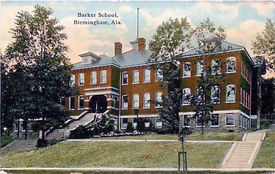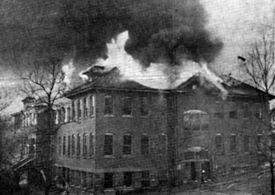Barker Elementary School: Difference between revisions
mNo edit summary |
No edit summary |
||
| (15 intermediate revisions by the same user not shown) | |||
| Line 1: | Line 1: | ||
[[ | {{Infobox former school | ||
[[ | |name = Barker Elementary School | ||
|image = [[File:Barker School postcard.jpg|275px]] | |||
|years = [[1905]]–[[1941]] | |||
|grades = 1-7 | |||
|enrollment = 527 | |||
|enroll-year = 1941 | |||
|colors = | |||
|mascot = | |||
|address = 1300 [[23rd Street North]] | |||
|city = Birmingham | |||
|map = ({{Locate_address_inline | address = 1300+23rd+St+N | zoom=17 | type=h }}) | |||
|district = [[Birmingham City Schools]] | |||
}} | |||
'''Barker Elementary School''' was a [[Birmingham City Schools|Birmingham school]] located on the corner of [[13th Avenue North|13th Avenue]] and [[23rd Street North]], lots 1 and 2 of [[Block 663]] in [[Druid Hills]] (then known as [[North Highlands]]). It was named for civil engineer [[William Barker]], who laid out [[Birmingham]]'s [[Birmingham city center street grid|city center street grid]] and resided in the area for three decades before his death in [[1899]]. | |||
The | The central portion of Barker School was built in [[1905]]. Invitations to bid stipulated that the building would contain a principal's office, a teachers' room, and at least eight classrooms, each with a capacity for 48 pupils. The building would also house a cloakroom with 96 numbered hooks and a washbowl, a 15-inch wide glass-fronted bookcase in each classroom, first-class blackboards, picture moulding, and daylight from the left or left rear of the pupils in each room. The basement was to have a concrete floor slab and be furnished with a manual training room with workbenches and a tool storage closet. The remainder to be used for hot air furnaces and janitorial storage. Automatic flushing toilets for boys and girls, telephonic or electric bells, and an electric fire alarm were also specified. The total cost of the school was not to exceed $25,000, of which $5,000 went for the land, $18,500 for construction and design fees, and $1,500 for furniture and equipment. The board set a date of [[March 27]], [[1905]] to review architects' proposals. | ||
Two wings were added to the school in [[1910]]. By [[1923]] the school, with 16 classrooms of varying size, had an enrollment of 972 students in grades 1 through 7 and was judged to be "overcrowded" in the Board's survey of that year. | |||
The insurance settlement | The school was destroyed by a fire which started in the boiler room during the early morning of [[March 14]], [[1941]]. The fire was discovered by [[Ralph Blue]], a ''[[Birmingham Age-Herald]]'' paper carrier who noticed flames at 5:10 AM while working his route. Companies from [[Birmingham Fire Station No. 1|Fire Station No. 1]], [[Birmingham Fire Station No. 4|No. 4]], [[Birmingham Fire Station No. 5|No. 5]], [[Birmingham Fire Station No. 9|No. 9]], [[Birmingham Fire Station No. 11 (1910)|No. 11]], [[Birmingham Fire Station No. 22|No. 22]] responded to the alarm, which Chief [[Alf Brown]] described as 'one of the meanest fires we've had in a long time." The flames, fueled by pine-framed walls was conducted from the boiler room to the roof through heat transfer ducts. The firefighters' efforts were hampered by the steep hilltop site. | ||
[[Image:Barker School fire.jpg|thumb|left|275px|''Birmingham Post'' photo of the school in flames. {{BPL permission caption|http://bplonline.cdmhost.com/u?/p4017coll2,845}}]] | |||
At the time of the fire, 527 students were enrolled in the school. They were transferred to [[17th Avenue Elementary School|Seventeenth Avenue]], [[Norwood Elementary School|Norwood]], [[Martin Elementary School|Martin]] and [[Powell Elementary School|Powell Schools]]. [[Henley School]] PTA president [[Harry Singler]] labelled the older Henley and Powell Schools as "firetraps" like Barker, and suggested that the board tear them down and replace all three with a single, modern combined school in a central location, presumably downtown near the existing Powell School site. Some parents of children that attended Barker resisted the idea of sharing a new school with children from the newly-opened [[Metropolitan Gardens|Central City Housing Project]], expressing concern over the risk of students having to cross the railroad tracks on [[10th Avenue North]]. Ultimately, the insurance settlement was used to build a new 8-room addition to the [[Seventeenth Avenue School]]. The damaged building was demolished and the cleared site became [[Barker Park]]. | |||
{{stub}} | {{stub}} | ||
==Principals== | ==Principals== | ||
* [[ | * [[George E. Wallace]], 1903–1910 | ||
* [[R. C. Johnston]], 1923 | |||
* [[Theo Wright]], 1926–1941 | |||
==References== | ==References== | ||
* "[https://www.newspapers.com/clip/73130506/naming-of-barker-school-in-birmingham/ The Barker School]" (May 9, 1904) {{BN}}, p. 6 | |||
* "Requirements for New Schools" (March 11, 1905) {{BN}}, p. 8 | |||
* {{Cruikshank-1920}} | |||
* {{BBOE-1923}} | * {{BBOE-1923}} | ||
* "[http://bplonline.cdmhost.com/cdm/ref/collection/p4017coll2/id/843 Early Morning Blaze Destroys Old Barker School]" (March 14, 1941) {{BN}} - via | * "[http://bplonline.cdmhost.com/cdm/ref/collection/p4017coll2/id/843 Early Morning Blaze Destroys Old Barker School]" (March 14, 1941) {{BN}} - via {{BPLDC}} | ||
* Kelly, Betty (March 14, 1941) "[http://bplonline.cdmhost.com/cdm/ref/collection/p4017coll2/id/843 Barker Pupils Deeply Moved]" {{BN}} - via | * Kelly, Betty (March 14, 1941) "[http://bplonline.cdmhost.com/cdm/ref/collection/p4017coll2/id/843 Barker Pupils Deeply Moved]" {{BN}} - via {{BPLDC}} | ||
* "[http://cdm16044.contentdm.oclc.org/cdm/ref/collection/p4017coll2/id/775 Barker Classes To Continue]" (March 15, 1941) ''Birmingham Age-Herald'' - via | * "[http://cdm16044.contentdm.oclc.org/cdm/ref/collection/p4017coll2/id/775 Barker Classes To Continue]" (March 15, 1941) ''Birmingham Age-Herald'' - via {{BPLDC}} | ||
* "[http://cdm16044.contentdm.oclc.org/digital/collection/p4017coll2/id/10923/rec/1 Parents Reject School Combine]" (March 25, 1941) ''Birmingham Age-Herald'' - via {{BPLDC}} | |||
* [http:// | |||
[[Category:1903 buildings]] | [[Category:1903 buildings]] | ||
[[Category:1903 establishments]] | |||
[[Category:1941 disestablishments]] | |||
[[Category:1941 demolitions]] | |||
[[Category:Burned buildings]] | [[Category:Burned buildings]] | ||
[[Category:Former elementary schools]] | [[Category:Former elementary schools]] | ||
[[Category:Birmingham schools]] | [[Category:Former Birmingham schools]] | ||
[[Category:13th Avenue North]] | [[Category:13th Avenue North]] | ||
[[Category:23rd Street North]] | [[Category:23rd Street North]] | ||
Latest revision as of 14:57, 18 October 2023
| Barker Elementary School | |

| |
| Active | 1905–1941 |
|---|---|
| School type | Public |
| District | Birmingham City Schools |
| Grades | 1-7 |
| Colors | |
| Mascot | |
| Location | 1300 23rd Street North, (map) Birmingham |
Barker Elementary School was a Birmingham school located on the corner of 13th Avenue and 23rd Street North, lots 1 and 2 of Block 663 in Druid Hills (then known as North Highlands). It was named for civil engineer William Barker, who laid out Birmingham's city center street grid and resided in the area for three decades before his death in 1899.
The central portion of Barker School was built in 1905. Invitations to bid stipulated that the building would contain a principal's office, a teachers' room, and at least eight classrooms, each with a capacity for 48 pupils. The building would also house a cloakroom with 96 numbered hooks and a washbowl, a 15-inch wide glass-fronted bookcase in each classroom, first-class blackboards, picture moulding, and daylight from the left or left rear of the pupils in each room. The basement was to have a concrete floor slab and be furnished with a manual training room with workbenches and a tool storage closet. The remainder to be used for hot air furnaces and janitorial storage. Automatic flushing toilets for boys and girls, telephonic or electric bells, and an electric fire alarm were also specified. The total cost of the school was not to exceed $25,000, of which $5,000 went for the land, $18,500 for construction and design fees, and $1,500 for furniture and equipment. The board set a date of March 27, 1905 to review architects' proposals.
Two wings were added to the school in 1910. By 1923 the school, with 16 classrooms of varying size, had an enrollment of 972 students in grades 1 through 7 and was judged to be "overcrowded" in the Board's survey of that year.
The school was destroyed by a fire which started in the boiler room during the early morning of March 14, 1941. The fire was discovered by Ralph Blue, a Birmingham Age-Herald paper carrier who noticed flames at 5:10 AM while working his route. Companies from Fire Station No. 1, No. 4, No. 5, No. 9, No. 11, No. 22 responded to the alarm, which Chief Alf Brown described as 'one of the meanest fires we've had in a long time." The flames, fueled by pine-framed walls was conducted from the boiler room to the roof through heat transfer ducts. The firefighters' efforts were hampered by the steep hilltop site.

At the time of the fire, 527 students were enrolled in the school. They were transferred to Seventeenth Avenue, Norwood, Martin and Powell Schools. Henley School PTA president Harry Singler labelled the older Henley and Powell Schools as "firetraps" like Barker, and suggested that the board tear them down and replace all three with a single, modern combined school in a central location, presumably downtown near the existing Powell School site. Some parents of children that attended Barker resisted the idea of sharing a new school with children from the newly-opened Central City Housing Project, expressing concern over the risk of students having to cross the railroad tracks on 10th Avenue North. Ultimately, the insurance settlement was used to build a new 8-room addition to the Seventeenth Avenue School. The damaged building was demolished and the cleared site became Barker Park.
Principals
- George E. Wallace, 1903–1910
- R. C. Johnston, 1923
- Theo Wright, 1926–1941
References
- "The Barker School" (May 9, 1904) The Birmingham News, p. 6
- "Requirements for New Schools" (March 11, 1905) The Birmingham News, p. 8
- Cruikshank, George H. (1920) History of Birmingham and Its Environs: A Narrative Account of Their Historical Progress, Their People, and Their Principal Interests 2 volumes. Chicago, Illinois: Lewis Publishing Company. - via Birmingham Public Library Digital Collections
- Birmingham Board of Education (1923) The Birmingham School Survey.
- "Early Morning Blaze Destroys Old Barker School" (March 14, 1941) The Birmingham News - via Birmingham Public Library Digital Collections
- Kelly, Betty (March 14, 1941) "Barker Pupils Deeply Moved" The Birmingham News - via Birmingham Public Library Digital Collections
- "Barker Classes To Continue" (March 15, 1941) Birmingham Age-Herald - via Birmingham Public Library Digital Collections
- "Parents Reject School Combine" (March 25, 1941) Birmingham Age-Herald - via Birmingham Public Library Digital Collections